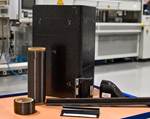Aerospace market report forecasts rapid composites growth by 2030
Persistence Market Researcher provides a comprehensive look on the recent developments shaping composites use in aerospace, detailing key market growth, challenges and emerging trends.
Photo Credit: Getty Images
Market researcher (New York, N.Y., U.S.) has recently released a comprehensive report that studies the global aerospace composites market. Forecasts suggest that this sector will reach a value of $62 billion by 2030 with a compound annual growth rate (CAGR) of 10.8%. This rapid growth is reported to be driven by a focus on enhancing fuel efficiency and sustainability, with advancements in composites technologies — including innovative manufacturing techniques — further propeling their integration into next-generation aircraft as a strategic necessity.
In its report, Persistence cites 10 market trends in the aerospace composites market. These include growing demand for lightweight solutions, environmental sustainability, increased use in critical components, technological advancements, cost-effective solutions, regulatory standards and certifications, collaborations and partnerships, R&D investments, emerging markets, and a focus on durability and safety.
However, with growth drivers, there are also challenges — primarily, supply chain and regulatory complexities appear. The report notes that the “intricate nature of aerospace composites, involving specialized materials and complex manufacturing processes, disrupts the supply chain’s seamless operation.” Considering aerospace’s reliable on specific fibers like glass, carbon or aramid fibers, their sourcing tend to significantly impact production costs.
Moreover, navigating intricate regulatory landscapes poses another hurdle. The aviation sector, governed by stringent safety and performance standards, imposes rigorous regulations on aerospace composites manufacturers and stakeholders. Ensuring compliance with evolving regulatory frameworks and maintaining adherence to demanding testing and certification procedures is crucial due to the distinctive compositions and manufacturing methods of composites.
Nevertheless, opportunities are still available in this market, particularly regarding sustainability goals — i.e., enhancing performance while reducing fuel consumption and carbon emissions.
The report identifies key players in aerocomposites and recent significant developments in this space. In addition, it breaks down research categories based on fiber type, matrix type, application (interior or exterior), composites manufacturing technique, aircraft category and geographical segment.
For the complete market report, visit .
Related Content
-
Infinite Composites: Type V tanks for space, hydrogen, automotive and more
After a decade of proving its linerless, weight-saving composite tanks with NASA and more than 30 aerospace companies, this CryoSphere pioneer is scaling for growth in commercial space and sustainable transportation on Earth.
-
Plant tour: Collins Aerospace, Riverside, Calif., U.S. and Almere, Netherlands
Composite Tier 1’s long history, acquisition of stamped parts pioneer Dutch Thermoplastic Components, advances roadmap for growth in thermoplastic composite parts.
-
“Structured air” TPS safeguards composite structures
Powered by an 85% air/15% pure polyimide aerogel, Blueshift’s novel material system protects structures during transient thermal events from -200°C to beyond 2400°C for rockets, battery boxes and more.






